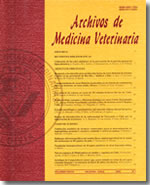Evaluación de protocolos de sedación y analgesia con xilazina y dos tasas de infusión continua de morfina en caballos en estación sometidos a castración vía laparascópica
Contenido principal del artículo
Resumen
El objetivo de este estudio fue evaluar la utilización de infusión continua de morfina a dos dosis distintas en cuanto a los niveles de sedación y analgesia en castración laparoscópica en caballos. Se utilizaron 14 caballos criollos colombianos, entre tres y seis años, y peso de 239 a 369 kg clínicamente sanos. A los animales se les administró xilazina (0,6 mg/kg IV), morfina (0,05 mg/kg IV) y se asignaron al azar a una infusión continua de morfina (20 o 30 mcg/kg/hora I.V) para posteriormente realizar transección de arteria y vena testicular mediante laparoscopia en estación por el flanco. Se evaluaron el grado de ataxia, sedación y analgesia, así como la motilidad gastrointestinal por auscultación y ecografía. Durante los procedimientos anestésicos y quirúrgicos los animales de ambos protocolos presentaron buena estabilidad cardiaca y respiratoria y todos los pacientes tuvieron una sedación de leve a moderada. La ataxia se presentó como moderada al inicio de la cirugía y durante procedimiento anestésico (luego del bolo de xilazina) y al final de la cirugía los animales presentaron un grado de ataxia leve a moderado. Alrededor del 93% de los animales tuvieron grados de analgesia de leves a moderadas a los estímulos quirúrgicos dolorosos principalmente el abordaje quirúrgico por el flanco y la ligadura y corte del paquete neurovascular testicular. La motilidad intestinal se disminuyó durante el procedimiento anestésico, pero todos los animales recuperaron totalmente la motilidad intestinal a las seis horas postcirugía. Los procedimientos anestésicos y quirúrgicos fueron apropiados para cirugía abdominal por laparoscopia en equino, con buena estabilidad cardiovascular y respiratoria y sin complicaciones gastrointestinales posteriores a la intervención.

